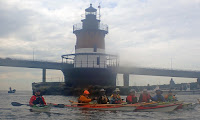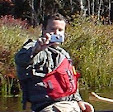Winter is upon us, and for those of us who are year-round boaters, it is time for a reminder on the dangers of cold water paddling, and how to minimize your risk.
How cold is cold water?
"Cold water" is probably not a cold as you think. The American Canoe Association sets its thermal protection threshold at 60 degrees. For us in southern New England, water temperatures generally don’t hit 60 degrees until sometime in June, and remain above that threshold until sometime in October. That means anyone paddling from November to May is paddling in cold water conditions.
 |
| Water Temperature in Narragansett Bay |
During the "off season", the water in southern New England can be very cold. Narragansett Bay reaches its coldest temperature (high 30’s to low 40’s) in late February/early March. While air temperatures increase quicky through the spring and early summer, water temperatures increase more gradually. The opposite is true in the fall when air temperatures drop quicker than water temperatures. Area rivers follow a similar pattern, but generally get 5 to 10 degrees colder in winter, and 5 to 10 degrees warmer in summer.
Why do we need to be concerned about cold water paddling?
There are three major risks resulting from cold water immersion - cold shock, physical incapacitation and hypothermia – and all three greatly increase the risk of drowning.
Cold shock comes first. It can happen the moment you hit cold water. Cold shock can cause a loss of breathing control often referred to as the “gasp reflex”. This is especially dangerous in rough water conditions where the ability to coordinate your breathing with wave splash is required.
Physical incapacitation comes next. Immersion in cold water causes your muscles and nerves to cool to the point that they simply stop working. In frigid water without protection you can lose the ability to use your hands in a matter of minutes, and the ability to use your arms and legs shortly thereafter, making a self-rescue or even an assisted rescue more difficult.
Hypothermia comes next. Hypothermia results from a drop in your core body temperature. To compensate, blood flow shifts from your extremities to the vital organs in your body core. This will eventually result in confusion and disorientation that can rob you of the ability to make sound judgments about your safety.
So how can you protect yourself if you are paddling in cold water?
Cold water immersion is a race against the clock, and for those who are not prepared, it can be a desperate race. When paddling in cold water conditions please remember:
Always, always, always wear your PFD
By keeping you floating at the surface, a PFD can reduce (but not eliminate) the risk of sudden drowning due to cold shock or physical incapacitation. Make sure that your PFD is properly sized and adjusted so it doesn’t rise up around your ears or slip off entirely.
Never paddle alone - three boats are recommended for safety
Physical incapacitation and mental disorientation are inevitable with cold water immersion, potentially making self-rescue impossible and assisted rescue more difficult. Paddling with a strong and knowledgeable group will increase your likelihood of getting back in your boat.
Keep the trip short, and well within the paddling ability of the group
We all like to push our abilities, but save long trips in difficult conditions for the warm water season. Don’t push the envelope in cold water conditions.
Dress for immersion in a wetsuit or drysuit
Beginners often make the mistake of under-dressing when the air is warm, but the water is cold. Since you can never rule out an unexpected swim, you should always dress for the water, not the air. Water is approximately 25 times more efficient than air at drawing heat away from your body, so you need protective gear like a wetsuit or drysuit to prevent excessive heat loss.
Layering for Paddlers
Boaters, like other outdoor adventurers, are wise to adopt a layering system for thermal protection. Layers allow you to add and remove pieces to match changing conditions, and help your body maintain a safe, comfortable temperature. These layers fall generally into three categories: base layers, insulating layers and outer layers.
Base Layers
Start with a moisture-wicking base layer next to the skin. Synthetic fabrics such as nylon, polyester and polypropylene work well since they don’t absorb water and move moisture from your skin. Stay away from cotton - it absorbs water, dries slowly and loses its insulating value when wet.
Insulating Layers
Insulating layers provide the thermal protection that allow you to remain warm, calm, and able to function while you’re in the water. Fabric based insulating layers hold in your body’s heat, but need to be kept dry under protective outer layers. Theses insulating fabrics include fleece, wool, and other insulating, non-absorbing materials. You can use multiple thin layers to adjust to a variety of conditions.
Neoprene is an insulating layer that will work well even when wet. Neoprene rubber contains thousands of tiny gas bubbles that slow down heat transfer. Neoprene “wetsuits” come in a variety of styles including “shorties”, "Farmer Johns" and separate shirts, jackets and pants. Farmer Johns (sleeveless wetsuits with full-length legs) are the most popular for paddlers since they protect the core and provide good freedom of movement, but they will need to be supplemented with additional layers in the coldest water. Wetsuits must fit tight to minimize the influx of cold water, and must be thick enough to provide appropriate insulation.
Outer Layers
Windproof and waterproof outer garments round out your cold water protection. An outer layer made with a material featuring a breathable coating or membrane is definitely preferable. This allows perspiration moisture to pass out of the garment, keeping the inner layers drier, and significantly increasing your comfort.
Splash wear is simply a waterproof outer layer that is designed to keep your under layers dry if you get splashed or rained on. If you’re using neoprene as your insulating layer, wearing a waterproof garment over it will cut down on evaporative cooling from the wet outer fabric of the wetsuit. If you go for a swim in splash wear, your inner layers will get wet.
Semi-dry wear is the next step in protection. These garments use neoprene gaskets, or a combination of neoprene and latex gaskets, to block water entry. Neoprene gaskets aren’t as efficient at keeping water out as latex, but they’re more comfortable and less expensive.
Drywear is the safest option for cold water paddling These garments use latex gaskets and booties to block water entry. This totally dry system allows you to customize your comfort and protection level by adjusting your insulating layers to match weather and water conditions.
Protect your extremities with a hat, neoprene gloves and warm footwear
Your mom always told you to wear a hat when it’s cold outside, because much of your heat escapes from your head. The same is true when paddling. If you are wearing a helmet, a helmet liner is a good investment. When it’s really cold, a neoprene balaclava is warmer than a helmet liner, and provides extra protection around the neck and face.
To keep your hands warm you have two main options: neoprene pogies or gloves. Neoprene gloves protect your fingers, but can hold water and reduce your grip on the paddle shaft. Pogies, on the other hand, don’t hold heat quite as well but drain easily and allow direct contact between your hand and the paddle. Try them both, or in combination to see what works best for you.
Neoprene boots are the preferred footwear when the water is cold. A wide variety of boots are available, most of which come with rubber soles to provide grip and protection when you walk on rocks.
Test your gear in real conditions
How will you know if you have the right gear and can function in cold water? Take a plunge to try it out. Do this in safe conditions with buddies nearby just in case. Testing will confirm that you can use your gear smoothly and effectively - even when you're under stress in cold water.
Don’t fall for excuses
There are lots of excuses from folks who don’t want to be bothered preparing for cold water paddling. Excuses like:
- I’m not going to capsize.
- The gear is too expensive.
- I brought extra clothing and warm drinks.
- I’ll paddle “close to shore” or in “protected waters”.
- I won’t encounter “challenging conditions".
- I paddle with a group and can quickly get back in my boat.
- It’s not that cold and I don’t want to overheat.
- It’s just a quick trip.
In cold water, it is not an exaggeration to say that excuses can kill you. Paddle safe, paddle smart and always prepare for the conditions.
Links:








































